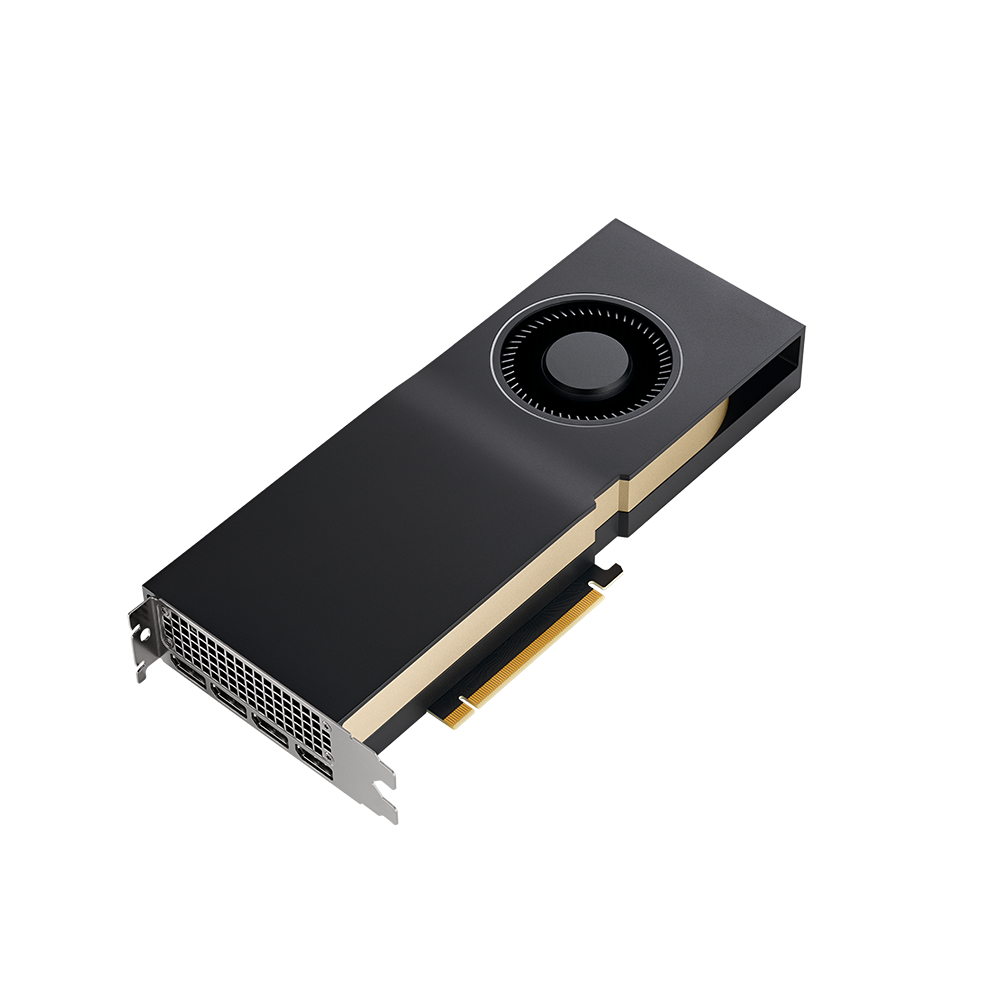Cut render times in half with the NVIDIA RTX A4500
Open up new creative channels and a faster iterative workflow.

Creative professionals are realising that NVIDIA RTX is a gamechanger. Whether you’re rendering 3D models, editing video, producing architectural visualisations or any other GPU-intensive task, the NVIDIA RTX A4500 dramatically cuts wait times and enables a more fluid creative process.
The architecture of the RTX A4500 is called Ampere, and it ramps up performance in the key areas of ray tracing and deep learning. Ampere-based CUDA cores can deliver up to twice the throughput of their predecessors, slashing render times and speeding up workflows.
Supercharge AI features
It’s no secret that AI technologies are transforming the world of video editing and visual effects, and NVIDIA RTX GPUs have the computational power you need to make the most of these technologies. RTX cards have Tensor Cores which are purpose-built to be amazingly efficient at maths involving grids of numbers called matrices. Matrix arithmetic is central to the handling of the vast neural networks involved in deep learning, so the AI-based functionality in your favourite software gets a massive performance boost.
The NVIDIA RTX A4500 has third generation Tensor Cores, which accelerate more datatypes than their predecessors, and also have separate data paths for whole numbers and those with a decimal point, which makes for more efficient number-crunching. They are also able to take shortcuts when handling sparse matrices that contain lots of zeroes, which can make them up to twice as fast overall.
So what sort of features will see a benefit? Faster Tensor Cores supercharge any tool that uses AI, so you’ll get a boost for all kinds of applications including 3D visual effects, graphic design and image and video editing. For example, the ground-breaking CopyCat feature in Nuke 13 enables visual effects artists to train a neural network tailored to the specific set of shots they are working on, and Topaz Labs Gigapixel AI can upscale an image by up to 600 percent while preserving image quality.
Real-time ray tracing
Ray tracing is a rendering technique that traces how rays of light bounce around a three dimensional space to produce photo-realistic results. Until recently it was thought that we were decades away from being able to produce it in real time, but NVIDIA has made this technology possible earlier than expected with the RTX series of GPUs.
There has recently been an explosion in real-time rendering in a number of industries, especially TV and film, animation, and architectural visualisation. Whether you’re a visual effects artist on a film set or an architect in a studio, this incredible technique transforms your workflow by giving you instant results. With its second generation Ray Tracing Cores, Ampere Architecture-based GPUs like the RTX A4500 are up to twice as fast at ray tracing compared to the previous generation, making all your real-time work quicker and smoother. This technology also speeds up the rendering of ray-traced motion blur for faster results with greater visual accuracy.
Beyond the cores
The CUDA, Tensor and RT Cores are the workhorses of the GPU, but they are enabled by some hefty supporting technology. The RTX A4500 supports PCI Express Gen 4, which provides double the bandwidth of PCIe Gen 3, improving data-transfer speeds from CPU memory for data-intensive tasks like AI and data science. There is also 20GB of higher speed GDDR6 memory, which is needed for tasks such as ray tracing, rendering, and AI workloads.
Real-time ray tracing and AI technologies are nothing short of a revolution, promising exciting possibilities that we can’t even fully imagine yet. It’s such a great time to be a creator, and NVIDIA’s RTX A4500 GPU is the computational powerhouse you need to enjoy these fantastic new technologies at their very best.

Thank you for reading 5 articles this month* Join now for unlimited access
Enjoy your first month for just £1 / $1 / €1
*Read 5 free articles per month without a subscription

Join now for unlimited access
Try first month for just £1 / $1 / €1
Get the Creative Bloq Newsletter
Daily design news, reviews, how-tos and more, as picked by the editors.
The Creative Bloq team is made up of a group of design fans, and has changed and evolved since Creative Bloq began back in 2012. The current website team consists of eight full-time members of staff: Editor Georgia Coggan, Deputy Editor Rosie Hilder, Ecommerce Editor Beren Neale, Senior News Editor Daniel Piper, Editor, Digital Art and 3D Ian Dean, Tech Reviews Editor Erlingur Einarsson, Ecommerce Writer Beth Nicholls and Staff Writer Natalie Fear, as well as a roster of freelancers from around the world. The ImagineFX magazine team also pitch in, ensuring that content from leading digital art publication ImagineFX is represented on Creative Bloq.
